sign language
Latest
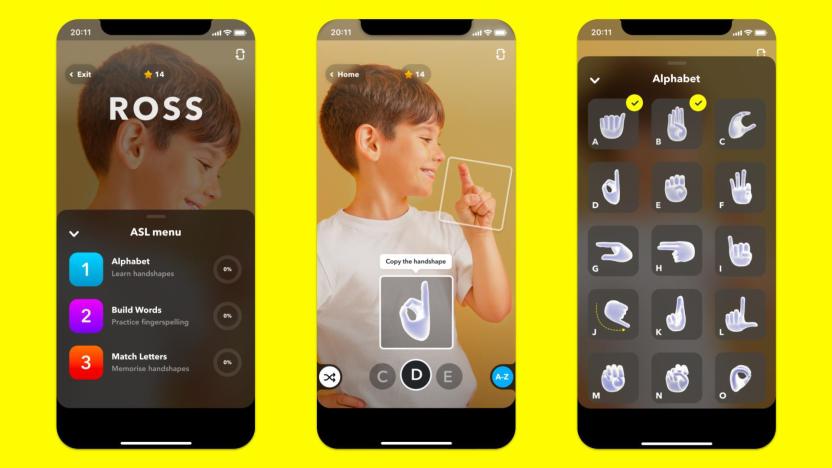
Snapchat's latest lens helps you learn the American Sign Language alphabet
Snapchat has unveiled a new lens that teaches you the American Sign Language alphabet.
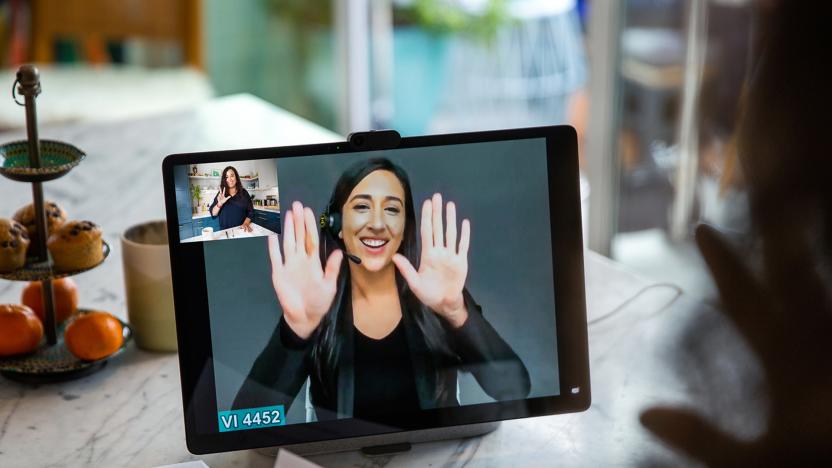
Portal users can now bring sign language interpreters into video calls
Meta Portal devices now serve as video relays for hard of hearing people who may need interpreters.
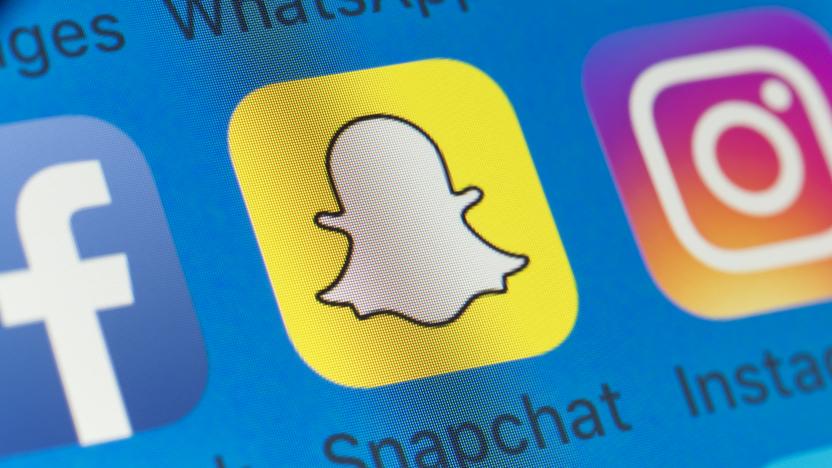
Snapchat's new lenses and stickers can teach you basic sign language
Snapchat is rolling out new augmented reality lenses and stickers that can give you cursory lessons on sign language.
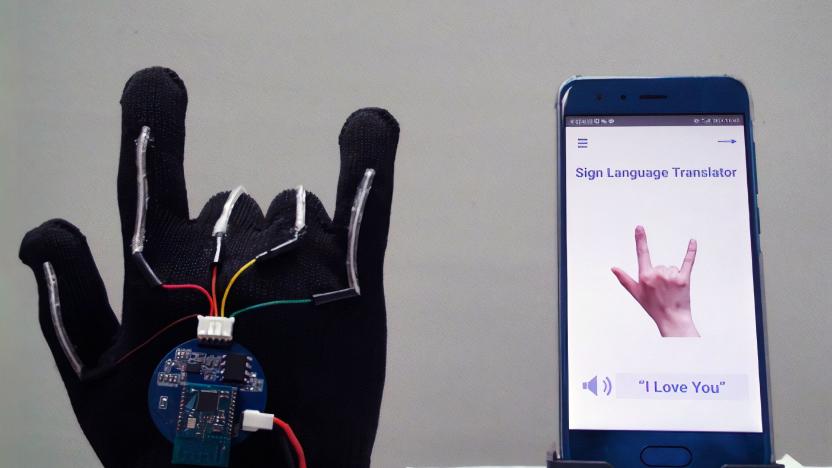
A high-tech glove can translate sign language with 99-percent accuracy
Researchers at UCLA have developed an inexpensive, high-tech glove that can translate sign language into written and spoken words on a smartphone.
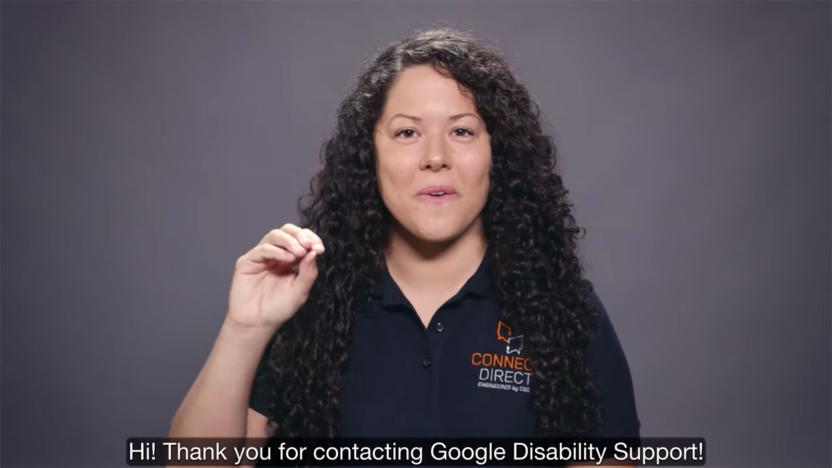
Google Disability Support is more accessible with sign language specialists
Google is now ready to offer live help for accessibility features regardless of your hearing. The search firm now offers Disability Support through American Sign Language, letting you troubleshoot through video chat if you're deaf or hard-of-hearing. Google reps can walk you through setting up Live Caption on your Pixel, for example.

Inhabitat's Week in Green: eco-friendly Christmas trees, Kingdom of Erebor Lego replica and a ring that translates sign language
Each week our friends at Inhabitat recap the week's most interesting green developments and clean tech news for us -- it's the Week in Green. At this time of year, you tend to see lots of cars with Christmas trees strapped to their roofs. But that could become a less common sight due to climate change -- extreme weather events are making life harder for tree farmers, causing tree shortages in the northeastern US. As an alternative, Inhabitat rounded up a list of this year's top eco-friendly faux Christmas trees. In New York, this year's Rockefeller Center Christmas tree is lit up with 45,000 solar-powered LED lights. In the spirit of the season, Russian photographer Alexey Kljatov took some stunning macro photos of snowflakes by hacking a cheap Canon PowerShot. Inhabitat also unveiled its annual green gadget gift guide, and we shared the real story behind the "design" of Christmas (hint: It involves Santa and 'shrooms).

Deaf gamer connects, educates through Wizard101
Even though she can't hear any of the music or sound effects in the game, Kelsey Fireheart professes a strong love for Wizard101. In a guest post on the KingsIsle blog, Kelsey shares a little of what it's like to be a deaf gamer and why this MMO means so much to her. Shortly after starting her adventures in the game, Kelsey had a profound encounter: "I remember questing in the Pyramid of the Sun of Krokotopia and I bumped into a fellow wizard named Diana Wildheart. She mentioned that she was deaf, and I gasped in astonishment. I replied, I am deaf too! That's when I realized that I could meet fellow deaf gamers through games like Wizard101." Kelsey said that this friendship made her realize that MMOs could be used for more than just fun and to educate others about what it's like to be deaf. "This game is a wonderful educational tool that I can use to teach countless others and it gave me a way of communicating with no barriers. In fact, it gave me a greater purpose within the game," she wrote. Kelsey said that the visuals of the game are quite important to her and that she wished sign language would be available as in-game emotes.

Marlee Signs teaches you sign language in your spare time
Marlee Signs is a sign language learning app for the iPhone that introduces you to the basics of American Sign Language (ASL). It is a joint project between MEDL Mobile and well-known deaf actress Marlee Matlin, who provides the sign language lessons for the app. Rather than just static diagrams, the app combines photos and videos to show you how to form ASL's standard hand signals. It includes seven video lessons from Matlin that cover the letters of the alphabet, numbers from zero to nine and common phrases like hello and goodbye. In these lessons, you watch Matlin as she signs the phrase. You can rewatch each video and slow down playback, which is helpful for learning a complex sign. Marlee Signs also includes a spelling section that lets you type in select words and watch how they are spelled using sign language letters. Instead of a video, this section of the app uses still photos of a hand. Each close-up photo shows the proper formation for each letter. Marlee signs is not a replacement for a comprehensive ASL class, but it is an excellent tutorial to introduce you to sign language. It's also a helpful companion for people who are taking a class and want to review the hand signals in their spare time. Marlee Signs is available for free from the iOS App Store. The app ships with seven basic lessons and you can buy five additional lessons for US$1.99 each.

Sigma R&D shows Kinect sign language and Jedi savvy to win gesture challenge (video)
Sigma R&D has won first prize in a gesture challenge to show just how much more talent -- like sign language translation and light saber fun -- can be unlocked in a Kinect. Normally the Microsoft device can only scope body and full mitt movements, but the research company was able to track individual fingers with a Kinect or similar sensor, plus its custom software, allowing a user's hand to become a more finely tuned controller. To prove it, the company introduced a virtual lightsaber to a subject, tracking his swordsmanship perfectly and using his thumb extension to turn it on and off. The system even detected when a passing gesture was made, seamlessly making a virtual transfer of the weapon. The same tech was also used to read sign language, displaying the intended letters on the screen for a quick translation. The SDK is due in the fall, when we can't wait to finally get our hands on a Jedi weapon that isn't dangerous or plasticky. To believe it for yourself, see the videos after the break.

Sign language translator turns gestures into spoken letters, makes for a better world (video)
By far one of the greatest challenges of sign language has been to translate it for everyday folk that wouldn't know where to begin a conversation with the deaf. Cornell University engineering students Ranjay Krishna, Seonwoo Lee and Si Ping Wang -- along with some help from Jonathan Lang -- used their final project time this past semester to close this gap in one of the more practical solutions we've seen to date. Their prototype glove uses accelerometers, contact sensors and flex sensors to translate complex finger gestures from the American Sign Language alphabet into spoken letters: after converting hand positions to digital signals, the test unit both speaks out the resulting letters and sends them to a computer, where they can be used for anything from a game (shown in the video below) to, presumably, constructing whole sentences. Along with being accurate, the Cornell work is even designed with a mind towards how it would work in the real world, as the glove and its transmitter are both wireless and powered by 9-volt batteries. We hope that the project leads to a real product and an extra bridge between the deaf and the rest of us, but in the meantime, we'll be happy that at least one form of powered glove is being put to the noblest use possible.

NHK's automated, animated sign language translator adds gestures to subtitles (video)
We've seen quite a few devices designed to help hearing impaired users communicate via phone or computer, but Japan's NHK Science & Technology Research Laboratories has just announced a new animated translation system to help get important news to deaf viewers . While televised subtitles may work for those who understand the language, people who were born deaf and learned sign language from an early age can have significantly more difficulty. NHK's system, unveiled at Technology Open House 2011, bypasses this problem by automatically comparing Japanese text to sign language, converting equivalent words into animated onscreen gestures, and replacing differing words with appropriate synonyms. There are, however, a few kinks to work out. While comprehensible, the translations aren't exactly fluent and researchers have been forced to manually adjust some awkward transitions between words. The ultimate goal is to create a system that could be used during emergencies or natural disasters, allowing deaf citizens to receive urgent broadcasts as instantly as their hearing compatriots. You can see it in action, after the break.

Storybook app integrates video of sign language for the deaf and hard of hearing
iStorytime has made a new app for reading with children, Danny the Dragon. It's not the content of the storybook, however that's got us excited. This app for iPhone and iPad is one of the first (if not the first) to include video of the story being read with sign language enhancement. Now, if you're expecting something super slick or high tech, you've come to the wrong place. This app incorporates simple videos of the story being read, and a woman signing along. Still, it's a pretty great use of applications, the power of mobile devices, and the app store ecosystem. Video of the app in action is below.

Microsoft says Kinect won't support sign language, downgraded cameras likely to blame
It was mentioned in the patent application, but it looks like Microsoft's Kinect won't be offering support for sign language after all. That's now been confirmed by Microsoft itself, which told Kotaku that it "files lots of patent applications to protect our intellectual property, not all of which are brought to market right away," before flatly stating that "Kinect that is shipping this holiday will not support sign language." The reason? It seems to be the result of Kinect's cameras, which Kotaku says were originally supposed to have a "much higher resolution," but were eventually downgraded to 320 x 240 in an apparent cost-saving move. If you parse Microsoft's, however, you'll noticed that it doesn't exactly rule out the possibility of Kinect ever supporting sign language; it simply says that the version launching this holiday season won't support it.

ZVRS to support live sign language translation via iPhone 4's FaceTime for calls between deaf and hearing users
While SMS and mobile email are great, they still can't match the emotion, interaction, and intonation of a live conversation with someone -- that's why our phones still ship with microphones and speakers, apparently. Of course, this is much more difficult when one of the parties is deaf or hard of hearing, which is where video relay services come in. With the help of a videophone or your computer's webcam, you can make a call with a live translator, who speaks your signed ramblings out loud to the hearing person on the other end. Of course you're usually stuck at a desk when doing this, but now ZVRS is going to be supporting calls made from the iPhone 4 over FaceTime. It might not be quite as sexy as Apple's goosebump-raising iPhone 4 commercial, since the phone obviously makes two-way sign language calls possible, but if the person on the other end doesn't have an iPhone 4 or doesn't know sign language, ZVRS seems like the next best thing. The new service will launch on July 26th. Check out a video of it in action after the break, the actual call starts at 2:25.

Valve researching sign language for use in Half-Life 2: Episode 3
Valve's Gabe Newell appears to have recently conducted a focus group with deaf individuals in order to learn more about sign language and how it can be applied to games, notably the upcoming Half-Life 2: Episode 3. Why? To help develop Alyx's character, and further the animation technology implemented in the Half-Life games. Newell explains: "[Alyx] had a crush on someone who was hearing impaired, so she taught Dog how to sign so she could practice. Something happened, maybe, the person is off fighting the Combine someplace else, but that's why she and Dog would start signing with each other when they wanted to communicate without making noise, or communicate without other people knowing ... It gave us the excuse to build the technology for signing." The focus group responds by noting the importance of facial expression whilst signing. While the Half-Life franchise has been known for its believable facial animation, it might take even more to fully realize the nuances necessary for authentic signing. It'll be interesting to see if Valve is up to the challenge.

Krown's handheld teaches you sign language
Sign language pocket tools aren't all that uncommon, but Krown's latest just exemplifies utility. This relatively low-fi device can reportedly display "short video clips showing how to sign any of 4,500 stored words in US sign language." Unfortunately, there's not a lot of details beyond that right now, but the firm is aiming to launch it in approximately three to four months at around $180.

VeeSee TV brings programming to deaf via IPTV
After hearing that modern technology wasn't exactly doing the deaf any favors, quite a few attempts have sought to reverse the unfortunate trend. Most recently, a new web-based television service has launched in the UK that brings sign language content to IPTV viewers 'round the clock. Dubbed VeeSee TV, the BSL (British Sign Language) channel is currently available via the internet or a set-top-box, and also "includes an interactive forum and user-generated content." Moreover, the creator suggests that this venue will allow "deaf film-makers to show off their own work" while allowing deaf individuals to conveniently catch catered programming anytime during the day. Notably, the service is a part of the ViewTV portal of channels, and while basic content should be up and running right now, a host of new functionality (including webcam conferencing) is planned for the upcoming months.

Detection algorithms to enable sign language on-the-go
Sure, texting has taken the entire world by storm and is likely to remain the next best option to actually speaking to someone for quite some time, but for those who feel that keying in paragraphs of information takes a bit too much time, they're looking for alternatives. Designed to assist the mute and deaf (or those who just love the limelight) who rely on cellphones, the MobileASL video compression project seeks to enable sign language over video telephony, even on less-than-speedy data networks. Developed at the University of Washington, the specialized skin detection algorithms are able to key in on critical moving parts (read: hands and fingers) and utilize the limited bandwidth to broadcast the most important vectors first. The ASL encoders are compatible with the H.264 / AVC compression standard, and while it wasn't directly stated just how viable this option was for those stuck on a 1xRTT connection, you can hit the read link to get in on the user studies if you're down with signing.[Via Slashdot]

Your feet do the talking in Sony's latest ad
Sony's ads just keep on getting weirder. Here's one for the PSP that involves sign language... for the feet. What could this possibly mean? Maybe it means your hands are too pre-occupied playing that your feet must do the talking... OR maybe Sony's working on a new DDR pad for the PSP! [Via AdJab]









